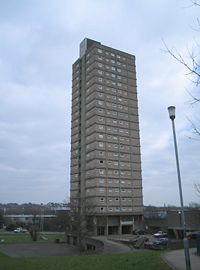
Back إسكان اجتماعي Arabic Sociální bydlení Czech Vivienda pública Spanish Sotsiaalmaja ET مسکن دولتی FA Logement social French דיור ציבורי HE Önkormányzati bérlakás Hungarian Perumahan umum ID Félagslegt húsnæði IS



Public housing is a form of housing tenure in which the property is usually owned by a government authority, either central or local. Although the common goal of public housing is to provide affordable housing, the details, terminology, definitions of poverty, and other criteria for allocation vary within different contexts. Within the OECD, social housing represents an average of 7% of national housing stock (2020), ranging from ~34% in the Netherlands to less than 1% in Colombia.[2][3]
In the United States, public housing developments are classified either as housing projects that are owned by a city's Housing authority or federally subsidized public housing operated through HUD.
Social housing is any rental housing that may be owned and managed by the state, by non-profit organizations, or by a combination of the two, usually with the aim of providing affordable housing. Social housing is generally rationed by a government through some form of means-testing or through administrative measures of housing needs.[4] One can regard social housing as a potential remedy for housing inequality.
Affordable housing goals can also be achieved through subsidies. Subsidized housing is owned and operated by private owners who receive subsidies in exchange for providing affordable housing. Owners may be individual landlords or for-profit or nonprofit corporations.[5]
- ^ Hong Kong Housing Authority (31 March 2021). "香港房屋委員會年報 Hong Kong Housing Authority Annual Report" (PDF). housingauthority.gov.hk. Archived from the original (PDF) on 4 February 2022. Retrieved 4 February 2022.
- ^ "Public policies towards affordable housing". OECD. 2024. Retrieved 6 March 2024.
- ^ "PH4.2 Social rental dwellings stock" (PDF). OECD. 15 March 2022. Retrieved 6 March 2024.
- ^ Caves, R. W. (2004). Encyclopedia of the City. Routledge. pp. 610. ISBN 9780415252256.
- ^ "Differences Between Public and Subsidized Housing - MassLegalHelp". Archived from the original on 6 October 2022. Retrieved 5 October 2022.